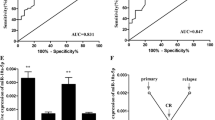Abstract
Purpose
MiRNA expression profiles previously showed the higher expression of microRNA(miR)-335 in bone marrow samples of pediatric acute myeloid leukemia (AML) patients than normal controls. Our aim was to investigate associations of miR-335 expression with tumor progression and prognosis in pediatric AML.
Methods
Real-time quantitative PCR was performed to detect the expression of miR-335 in bone marrow mononuclear cells and serum obtained from patients with pediatric AML and healthy controls.
Results
Expression levels of miR-335 in the bone marrow and serum of pediatric AML patients were both significantly higher than those in normal controls (both P < 0.001). Then, high serum miR-335 level occurred more frequently in French-American-British classification subtype M7 subtype than in other subtypes (P = 0.03). The expression of serum miR-335 in pediatric AML patients with unfavorable karyotypes was also significantly higher than those in intermediate and favorable groups (P = 0.008). Moreover, high serum miR-335 level was markedly associated with shorter relapse-free and overall survivals (both P < 0.001) of patients with pediatric AML. Furthermore, the multivariate analysis identified the serum miR-335 and cytogenetics risk as independent prognostic factors for both relapse-free and overall survivals. More importantly, the prognostic relevance of serum miR-335 expression was more obvious in the subgroup of patients with intermediate-risk cytogenetics.
Conclusion
Our data offer the convincing evidence for the first time that serum miR-335 level may be markedly and consistently increased in pediatric AML patients. Serum miR-335 may serve as a promising marker for monitoring the progression and predicting the clinical outcome of patients with this disease.



Similar content being viewed by others
References
Russell NH. Biology of acute leukaemia. Lancet. 1997;349:118–22.
Bonnet D, Dick JE. Human acute myeloid leukemia is organized as a hierarchy that originates from a primitive hematopoietic cell. Nat Med. 1997;3:730–7.
Estey EH. Acute myeloid leukemia: 2013 update on risk-stratification and management. Am J Hematol. 2013;88:318–27.
Ganetsky A. The role of decitabine for the treatment of acute myeloid leukemia. Ann Pharmacother. 2012;46:1511–7.
Puumala SE, Ross JA, Aplenc R, Spector LG. Epidemiology of childhood acute myeloid leukemia. Pediatr Blood Cancer. 2013;60:728–33.
Danen-van Oorschot AA, Kuipers JE. Differentially expressed miRNAs in cytogenetic and molecular subtypes of pediatric acute myeloid leukemia. Pediatr Blood Cancer. 2012;58:715–21.
Liu X, Liu L, Xu Q. MicroRNA as a novel drug target for cancer therapy. Expert Opin Biol Ther. 2012;12:573–80.
Esteller M. Non coding RNAs in human disease. Nat Rev Genet. 2011;12:861–74.
van Kouwenhove M, Kedde M, Agami R. MicroRNA regulation by RNA binding proteins and its implications for cancer. Nat Rev Cancer. 2011;11:644–56.
Jansson MD, Lund AH. MicroRNA and cancer. Mol Oncol. 2012;6:590–610.
Nana-Sinkam SP, Croce CM. Clinical applications for microRNAs in cancer. Clin Pharmacol Ther. 2013;93:98–104.
Esquela-Kerscher A, Slack FJ. Oncomirs-microRNAs with a role in cancer. Nat Rev Cancer. 2006;6:259–69.
Medina PP, Slack FJ. microRNAs and cancer: an overview. Cell Cycle. 2008;7:2485–92.
Zhu C, Wang Y, Kuai W. Prognostic value of miR-29a expression in pediatric acute myeloid leukemia. Clin Biochem. 2013;46:49–53.
Zhi F, Cao X, Xie X. Identification of circulating microRNAs as potential biomarkers for detecting acute myeloid leukemia. PLoS One. 2013;8:e56718.
Croce CM. MicroRNA dysregulation in acute myeloid leukemia. J Clin Oncol. 2013;31:2065–6.
Zhang H, Luo XQ, Zhang P. MicroRNA patterns associated with clinical prognostic parameters and CNS relapse prediction in pediatric acute leukemia. PLoS One. 2009;4:e7826.
Png KJ, Yoshida M, Zhang XH. MicroRNA-335 inhibits tumor reinitiation and is silenced through genetic and epigenetic mechanisms in human breast cancer. Genes Dev. 2011;25:226–31.
Yan Z, Xiong Y, Xu W. Identification of hsa-miR-335 as a prognostic signature in gastric cancer. PLoS One. 2012;7:e40037.
Heyn H, Engelmann M, Schreek S. MicroRNA miR-335 is crucial for the BRCA1 regulatory cascade in breast cancer development. Int J Cancer. 2011;129:2797–806.
Cao J, Cai J, Huang D. miR-335 Represents an independent prognostic marker in epithelial ovarian cancer. Am J Clin Pathol. 2014;141:437–42.
Peng HH, Zhang YD, Gong LS. Increased expression of microRNA-335 predicts a favorable prognosis in primary gallbladder carcinoma. Onco Targets Ther. 2013;6:1625–30.
Wang Y, Zhao W, Fu Q. miR-335 suppresses migration and invasion by targeting ROCK1 in osteosarcoma cells. Mol Cell Biochem. 2013;384:105–11.
Conflict of interest
None.
Author information
Authors and Affiliations
Corresponding author
Additional information
X. Lin and Z. Wang contributed equally to this work.
Rights and permissions
About this article
Cite this article
Lin, X., Wang, Z., Zhang, R. et al. High serum microRNA-335 level predicts aggressive tumor progression and unfavorable prognosis in pediatric acute myeloid leukemia. Clin Transl Oncol 17, 358–364 (2015). https://doi.org/10.1007/s12094-014-1237-z
Received:
Accepted:
Published:
Issue Date:
DOI: https://doi.org/10.1007/s12094-014-1237-z




